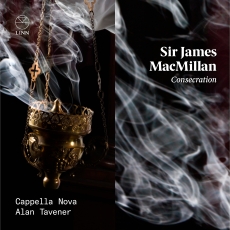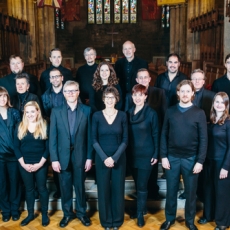Cappella Nova - MacMillan: Consecration - MusicWeb International
This is the fourth CD of music by James MacMillan that Alan Tavener and Cappella Nova have recorded for Linn. I’ve heard the previous discs and admired them very much. The value of this latest collection is enhanced because the vast majority of the music has never previously been recorded. It seems that the organ piece, Kenga e Krushqve has appeared on disc before, and though The St Anne’s Mass has been recorded in the past, this is its first professional recording. All the other pieces are new to the catalogue.
Speaking from personal experience, I feel that, with the honourable exceptions of a few churches and cathedrals, musical life in the Roman Catholic church in the UK is in a poor state. Sir James MacMillan stands as a shining example of what can be achieved if clergy (in particular), musicians and congregational leaders are prepared to make an investment of time and resources and if congregations are willing to embrace interesting music in the liturgy. MacMillan has written significant amounts of music that enrich the Catholic liturgy and a good deal of it is within the reach of a good, well trained parish choir. Furthermore, the music is accessible so congregations won’t be left scratching their heads in bewilderment.
The St Anne’s Mass is a fine example of music that could, with a bit of practice and familiarity, be taken up by a congregation. It’s expressly written for a congregation to sing in unison, well supported by the organ, and at times an SATB choir is brought into the mix. Originally written in 1997, on this disc we hear it in the composer’s 2011 revision which uses the new translation of the Ordinary of the Mass, which was imposed a few years ago in place of what was, in my opinion, a perfectly acceptable existing translation. I like the music very much: it’s user-friendly, though without any suggestion of “dumbing down”. The stand-out movement is the Sanctus. Here, MacMillan uses an original melody which he’d composed for a song, Tryst when he was in his twenties. It’s a most attractive melody and very Scottish in feel. A much more recent unison setting of The Lord’s Prayer (2018) is inserted in its proper liturgical place between the Sanctus and Agnus Dei.
The Mass is, by design, simple in concept. At the opposite pole stands A Special Appeal. This was composed at the request of Westminster Abbey to mark the centenary of the birth of Blessed Óscar Romero, the Archbishop of San Salvador, who was assassinated while saying Mass in his cathedral. Here, at the Abbey’s suggestion, MacMillan sets, in English translation, the sermon that Romero preached at that very Mass. It’s a very dramatic, bold setting in which the composer says he revisits the sort of music he was writing in the powerful Cantos Sagrados (1990), an important work which, to the best of my knowledge, has only been recorded once. The result is a superb piece which is here performed with blazing conviction. In her notes, Rebecca Tavener says of the music: “Full of drama…, it feels like a mini sacred opera”. That’s spot on, I think.
There are also a number of pieces here with very strong family connections. Lux aeterna was composed for the funeral Mass of MacMillan’s father at which the composer, his daughter Clare and Rebecca and Alan Tavener formed a small Schola to sing the music. Lux aeterna is the Communion Antiphon from the Requiem Mass. It’s set for solo soprano accompanied very simply by a double organ drone. The vocal part is challenging and wide-ranging; Rebecca Tavener sings it very well.
On a happier note, there are several wedding pieces. Wedding Song was composed as the entrance antiphon for the service at which Clare MacMillan was married. An exuberant toccata-like organ introduction sets the tone for a choral piece that is suitably joyful although, as a surprise for his daughter, MacMillan added a quiet conclusion in which he quotes from an earlier wedding piece which she had liked. The other wedding pieces were for the wedding of his son, Aidan MacMillan. I infer that his bride, Kleida is Albanian because the organ recessional, Kenga e Krushqve is an arrangement of a traditional Albanian song, made at Kleida’s request: the title means Song or Dance of the in-laws. It’s a jolly and sprightly piece. Behold, you are beautiful, my love and Until the day breathes were also written for Aidan and Kleida’s wedding. Both are choral pieces and both would grace any wedding celebration.
Although all the music on this disc is first rate, pride of place must go to The Culham Motets. This is a set of no less than five a cappella motets. These were commissioned by the Swiss philanthropists, Urs and Francesca Schwarzenbach to be sung at the consecration of a new chapel which they had built on the estate of their country home, Culham Court. Though I can’t find any reference in the booklet identifying it, I discovered that the photograph inside the cover of the CD is a picture of the exterior of this handsome building.
The motets set a variety of scriptural texts. All of them are very fine and most interesting. The second is ‘I saw water flowing’ and, appropriately, MacMillan writes overlapping wordless soprano parts which vividly suggest the sound of flowing water. (This is a device we shall encounter in two or three other pieces on this CD.) The sound of the soprano voices is mesmerising. The male voices declaim the text in music that is much more emphatic. Towards the end the full choir sings an extended, lyrically rapt sequence of ‘Alleluias’. This is a wonderful piece. In the third motet, ‘See the place where God lives’, the text is sung by a solo soprano while underneath her music the rest of the choir softly intones again and again the words ‘How lovely is your dwelling place, Lord God of Hosts’, the harmony warm and restful. The solo part is entrusted to Rebecca Tavener and she offers highly skilled and deeply committed singing. In ‘From the hand of the Angel’ MacMillan fashions circling halos of wordless soprano writing, which sound almost aleatoric. Meanwhile, a solo tenor sings the text, his music chant-like; this chant is later taken up by all the male voices. All five of these motets are significant compositions in their own right; heard as a sequence, one’s admiration for them increases even further.
This is a terrific disc, showing contemporary liturgical music at its very best. Alan Tavener and Cappella Nova have already proved themselves to be highly skilled and greatly committed advocates for James MacMillan’s music and once again they serve him exceptionally well. The singing is superb throughout and Stephen McIntyre makes a very fine contribution at the organ.
Engineer Philip Hobbs has recorded the performances expertly and Rebecca Tavener’s notes are valuable.
This is an important addition to the MacMillan discography.

